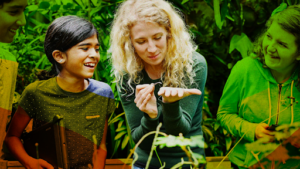How Women Are Transforming Leadership for Climate Justice
Originally published by Mallory McDuff for the Sierra Club
Imagine wrapping an extra blanket around the planet, climate scientist Katharine Hayhoe has said, causing its temperature to rise. To describe our warming planet, Hayhoe uses the analogy of a fever caused by carbon emissions. Much like a raging fever can threaten a child’s life, the difference of a few degrees, of course, carries catastrophic impacts. “How could I not do everything I could to fix this huge global challenge?” Hayhoe asked back in 2016.
This comparison made sense to me: A mother of two who has stayed up many nights tending to my daughters’ fevers, I know what it’s like to do everything in my power to care for someone. As a professor of environmental education at a small college in the Appalachian Mountains of North Carolina, I also know what it’s like to spend time with young people daunted by the enormity of the climate crisis. For my children and my students, I set out to explore how women across the country are confronting the climate emergency—and I discovered that unconditional love, much like how it affects our relationships in ordinary life, can shape climate leadership.
The women I wrote about in Love Your Mother: 50 States, 50 Stories, and 50 Women United for Climate Justice (2023, Broadleaf Books) each have something to teach us, not just about caretaking but also about how to lead in a crisis—especially one that most affects poor and marginalized communities, with a disproportionate impact on women. “The climate crisis is not gender-neutral,” wrote Katharine Wilkinson and Ayana Elizabeth Johnson, coeditors of the anthology All We Can Save. Indeed, 80 percent of those displaced globally by climate change are women and girls.
My journey highlighted the stories of farmers, poets, scientists, physicians, teachers, students, and more—one woman in every state in the US. Many Indigenous activists, like attorney Tara Houska, show love-based leadership in the grassroots fight for clean water and air for their communities by positioning their bodies against the Line 3 tar sands pipeline in Minnesota. “Quite simply, I don’t believe we will solar panel or vote our way out of this crisis without radically reframing our connection with our Mother,” Houska wrote in All We Can Save. Likewise, fifth-generation Montanan high school student Grace Gibson-Snyder draws on her connection to her family and the land as a plaintiff in the case Held v. State of Montana. Gibson-Snyder is fighting in court for the constitutional right of young people to a healthy life.
From these women, I learned that love is a muscle we can all strengthen as we transform the ways we work together—pushing to dismantle the structural systems that maintain the fossil fuel economy and building a healthy future for all. The unconditional love these women have for the land they inhabit and the air they breathe showed me the possibility of reshaping climate leadership through collaboration, communication, and community.
When I spoke with farmer, birth doula, and restaurant owner Tiffany Bellfield-El-Amin of eastern Kentucky, for instance, I immediately realized she didn’t engage in any task if it wasn’t collaborative. “On a given day, I’ll visit several pregnant moms, and maybe catch a placenta if I assist at a birth,” Bellfield-El-Amin told me. “Then I might meet with farmers through the Community Farm Alliance and later grocery shop for the restaurant.”
A third-generation Black farmer in a state with only 600 Black-owned agricultural businesses, Bellfield-El-Amin lives at the intersection of food, health, and climate justice in rural Kentucky. In her personal life and in her community, she says she’s seen how nutrition and health care can promote wellness in times of crisis. And as a food justice organizer, she provides technical assistance to farmers to ensure they have resources to adapt to the climate crisis with resilient food systems.
